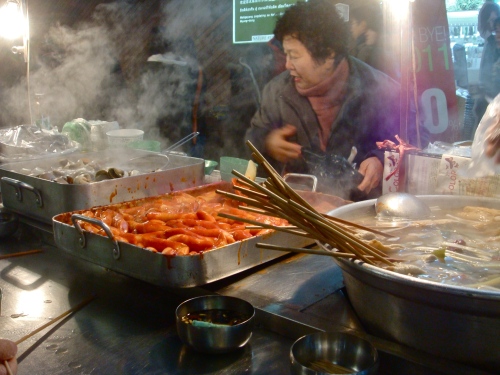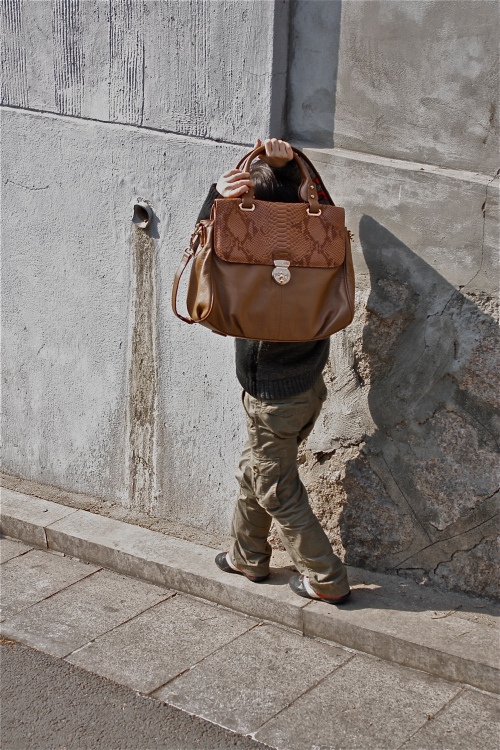for the love of hoddeok
Women wrapped in fogs of steam from big pots of ddeokbokki or men running ladles through hot broth baths of odeng are images I will carry with me forever. Street food culture is round-the-clock in Seoul. No matter when and where you are, you never have to walk far to find something hot, fast, and cheap to eat.
(ddeokbokki: tubes of rice cake stewed in fiery, sweet red sauce)
(odeng: pounded fish cake boiled and zigzagged around long wooden skewers)
(stalls near Dongdaemun Market, one of the best spots for street food in Seoul)
Think pan-fried pork and scallion dumplings, double-battered corn dogs, sliced fried potato on a stick, and rice balls flecked with carrot, kimchi and salty dried seaweed. If nothing else, think righteously sweet stuffed pancakes that could rival a bag of mini donuts from the Minnesota State Fair. If we here in South Korea dedicate a day every year to a pre-packaged, chocolate-covered biscuit, these toothsome beauties deserve a weeklong celebration. As a child who would reach for juice from the dill pickle jar over a piece of birthday cake, that proclamation feels borrowed even now. Apparently, tastes be a changin.’ When Flo left the world as we know it last fall, I think she left her insatiable sweet tooth to me.
I can’t remember where in Seoul I first tried hoddeok, but it was this past winter, and I’m certain my nose led the way. Cold air nipped bare cheeks of passerby, muting scents that would soar in hot weather. The aroma of cinnamon sugar snapped me out of a hustle to get to wherever I was going, my head whipping around to try to identify the source of it. I was strangely surprised to realize I wasn’t smelling churros. It was hoddeok, and it seduced me by way of all senses. The sound of dough frying lightly in oil, the taste of melted, brown sugar against cinnamon-spiked dough, the warmth and give of a freshly fried pastry in the palm of my hand. And just like the smell of perking coffee, one whiff of cinnamon sugar and I feel like a new woman. Every time.
If you live in Korea and you’re reading this, I won’t try to convince you to make hoddeok on your own. Not when you can step outside and have one on your tongue in fifteen minutes or less. But maybe you’ve never lived in or traveled to Korea, and you’re up for trying a new take on a familiar flavor. Or maybe you used to live in Korea (hi, Jen!) and you miss a thing or two about it. This recipe works, and despite the lengthy instructions, putting together a batch of hoddeok is actually pretty simple.
Chris deserves all the credit for this inspiration. He found and tweaked the recipe, made it for breakfast one day, and quietly stood by while I was overzealous, even though he knew the tried-and-true spiced sugar filling works best. Note: chocolate-banana-honey-filled hoddeok is not as awesome as it sounds!
For 4-6 hoddeok
2 cups flour
1 cup warm water
1/2 teaspoon instant dry yeast
Pinch salt
Oil for frying
Cinnamon Sugar (Mix 1/4 cup light or dark brown sugar with 1 teaspoon cinnamon. Optional: Stir in 2-3 tablespoons of chopped almonds, walnuts, pecans, or peanuts to the remainder of the mixture.)
Stir water and yeast together in a cup until the yeast is dissolved. Let sit for ten minutes.
Sift flour, salt, and one tablespoon of cinnamon-sugar together into a large bowl. The sifter will catch the nuts, but if you decide to skip this step, just mix together some cinnamon-sugar separately to add to the dry ingredients. You don’t want nuts in the dough.
Mix yeast/water in with the dry ingredients. It comes together quickly. You want the dough to spring back from the sides of the bowl when you turn a spoon around it. It should be sticky but not shiny and wet. To get the right texture, you’ll probably need to add a bit of flour (I always do), but don’t worry about getting it perfect. One of the reasons I love making this is because of how unbelievable it tastes despite the fact that I’ve got no idea how the perfect hoddeok dough looks or tastes. Odds are, your first attempt will taste unbelievable, too.
Cover with a warm damp towel and let sit out at room temperature for an hour. Alternatively, you could cover the dough and keep in the refrigerator overnight.
The first few cakes can be frustrating to assemble. The dough will be sticky, and the sugar filling will try to go any which way but where you want it to. Take your time. You must layer a good slick of oil on your hands, the pan, and the surface of your flattening tool (the back of a spatula works well).
Here’s what you need on your assembly line of hoddeok production: dough, dish of cinnamon sugar, spoon, spatula (or other flattening tool), pan, plate (for finished pancakes).
With greased hands, pinch a handful of dough about the size of a plum. Flatten, leaving a dip in the center for the sugar. Spoon a tablespoon+ of cinnamon sugar into the dip. Bit by bit, bring the outer edges of the dough up to the center, sealing the edges together and trapping the sugar inside. The finished product will look like a ball. Set the stuffed dough balls on a plate to rest until you are ready to start frying. When you’re ready, heat a couple of swirls of oil on medium-high in a pan.
Once the hoddeok hits the pan, flatten it with the back of your spatula to at least 1/2 inch thick. I like mine puffy, closer to 3/4 inch thick. After you’ve flattened the cake, let it brown on one side before flipping it. Once it’s flipped, turn the heat to low and cover the pan. You want the outside of the pancake to crisp and brown nicely, and it’s most important that the sugar has enough time to melt inside of the dough. Cover the pan to let the heat melt the sugar. The dough should be cooked and the filling should turn to a gorgeous melted bullseye of cinnamon-sugared heaven. It’ll be hot, so wait and let it cool outside of the pan for a minute. Not too much longer, though, as the sugar will harden as it cools.




